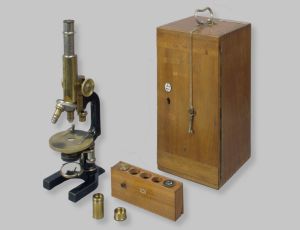
Exhibit of the Month is a series initiated by the Jagiellonian University Museum with the beginning of the new academic year. Each month we will explain the Museum collection to you, choosing a single exhibit or a group of exhibits which usually are not shown to the open public. This month's feature is a Reichert microscope.
Modern scientific equipment ages quickly, not only because of the rapid development of technology, but also because of the low durability of the materials used in its manufacture. Back in the 20th century, scientific instruments served for decades. An example is microscopes which were sometimes used by several generations of scientists. Made of good quality materials, robust and durable, relatively simple in design, they could be adapted to the user's needs. The most important thing about them was the optics and illumination of the microscopic slide; if they met the requirements, the microscope was often indestructible. New instruments were purchased primarily due to the introduction of new microscope techniques and design solutions — such as a heated or polarised stage.
The Carl Richter company, founded in 1876 in Vienna, was one of the leading manufactures of microscopes. Instruments from this company, along with Carl Zeiss microscopes, were often purchased for the Jagiellonian University laboratories, primarily because of their excellent optics. The object on display dates from the early 20th century. It has an illumination system supported by an Abbe condenser with an iris diaphragm and filter, the position of which could be precisely adjusted using a micrometre screw gauge. In addition to the macro and micrometre screws, a continental-type micrometre extractor was used in the barrel. A tilting tripod with a solid foot equipped with a characteristic spur allows the observation line to be set at an angle. This is useful for better illumination of the slide and also gives free access to the stage.
The microscope was donated in 2007 by Prof. Dr hab. Tadeusz Cichocki, the head of the JU Chair and Department of Histology. The object, created at the beginning of the 20th century, was used by Docent Dr hab. Jadwiga Ackermann both for research and documentation work, as well as in secret teaching. It continued to be used for educational purposes after the war, more than 40 years after it was made. However, the most unique part of its history is linked to the discovery of the mass graves of the Polish military elite at Katyń. During the 1943 exhumation of the remains of Poles murdered by the Soviets in April and May 1940, numerous documents and artefacts were collected. Packed into numbered envelopes, they were brought to Kraków. Their cleaning, preservation and identification were handled by the team of Professor Jan Robel (1886-1962), a medical toxicologist, composed mainly of
employees of the Chemical Department of the State Institute of Forensic and Criminal Medicine. The institution was created by the German occupier from the Forensic Chemistry Department of the Jagiellonian University. The team included Jan Cholewiński, a chemist, graphologist and photographer, Jadwiga Ackermann, a histologist and chemist, Maria Paszkowska, a pharmacist, Irma Fertner, a secretary, and Ludwik Kamykowski, a literary historian, as well as three people from outside the Chemistry Department: Stanisław Paszkowski from the JU Neurological and Psychological Clinic, Maria Dembecka and Rozalia Plizowska. Jadwiga Ackermann researched organic matter, above all conducting histological studies of tissues extracted from the envelopes, but she was also involved in the cleaning and preparation of documents and the unpicking of pages. Thanks to the work of the team, it was possible to establish the personalities of 266 victims, and to clean and preserve materials from nearly 300 envelopes, not to mention diaries and documents examined in secret to escape attention from the Germans. The research reports, together with supporting documents, formed the so-called Robel Archive, which is the central piece of the Katyń massacre documentation. The official documentation was most likely destroyed by the Germans at the end of the war, but a copy of Robel's archive was found in 1991 (one set, then a second copy and more material was revealed). Many of them bear Ackermann's signature, documenting her work carried out with this microscope.
Jadwiga Ackermann (1901–1985) received her habilitation degree in August 1939, making her the eleventh, and last, woman to achieve that academic rank at the Jagiellonian University before the Second World War. She specialised in histology and became a professor in 1953. She was head of the Histology Department at the Medical Academy in Kraków.
Optical compound microscope, Carl Reichert, Vienna, 1910–1911. Donated by the JU CM Chair and Department of Histology, 2007.
Text: Dr Małgorzata Taborska, Museum Collections Department

